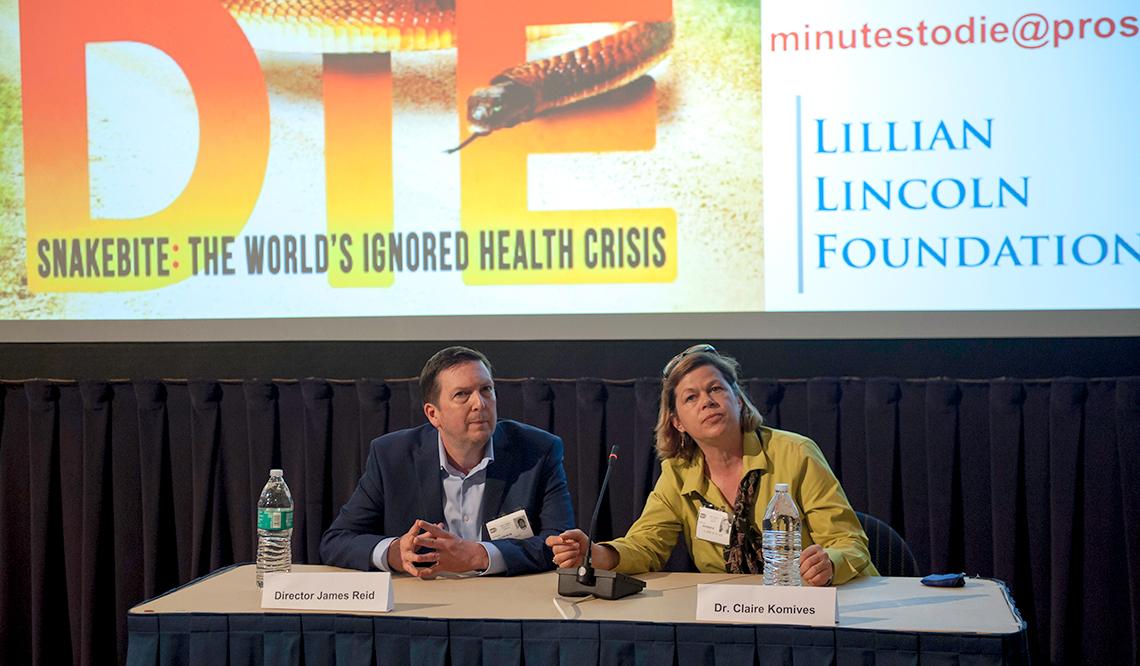‘Minutes to Die’
Film Illustrates the Ruin of Snakebite

Photo: Marleen Van Den Neste
In an effort to draw the world’s wavering attention to the problem of snakebite—“the most neglected of the world’s neglected tropical diseases”—filmmaker James Reid brought his documentary Minutes to Die to Lipsett Amphitheater recently.
Sponsored by NIH’s global health interest group, the viewing, a 62-minute version of a longer film, was followed by a panel discussion with Reid and Dr. Claire Komives, a professor at San Jose State University. She is working on a “tiny ribosomal peptide” harvested from opossum serum that broadly neutralizes snake venom. Opossums are naturally immune from most American snake venoms, which are toxic stews relying primarily on metalloproteases to do their damage.
Scale of Problem
Five million people a year are bitten by snakes, mainly in the tropics, and hundreds die daily. Snakebite kills 125,000 people a year—the entire population of Topeka, Kan., or Bern, Switzerland, for example—and often imposes economic ruin on victims and their families, whether or not they survive. As many as 2 to 3 times that number are maimed, disfigured or suffer amputation due to snakebite. According to the film, as many people die from bites in a month as died during the 26 months of the last African Ebola crisis.
“It is the world’s most ignored way to die, and it will continue until the world takes notice,” says film narrator Mike Rowe, known to local audiences for his TV ad work and as host of the Discovery Channel’s Dirty Jobs and CNN’s Somebody’s Gotta Do It. “It’s a fixable problem—the solution is not complicated.”
Back in 2009, snakebite made the World Health Organization’s neglected tropical diseases (NTD) list, but it was removed shortly thereafter, said Reid. It recently was restored to the list, making it eligible for research funds from WHO-sponsored donors.
The vast majority of those bitten by snakes go to traditional healers and medicine men in their villages—that’s the only available health care, in many cases. But that only delays effective medical care, which can sometimes be days away by foot or vehicle. Victims are usually impoverished farmers or herdsmen; city dwellers in many affected countries “are genuinely ignorant of their plight,” according to the film.
In the tropics, snakebite is more feared than tuberculosis, malaria and HIV/AIDS, the film maintains. Even tsunamis are considered less of a threat. Yet snakes do offer a service—they keep rodents from destroying farms.
Anti-venom is effective, if administered in time, but drug companies find it unprofitable to manufacture and stores of it are depleted in rural Africa and India, where the need is greatest.
Snake venoms fall into one of three categories: hemotoxins, which cause uncontrolled bleeding; neurotoxins, which paralyze breathing; and cytotoxins, which destroy tissue. There is no universal anti-venom.
From 1894 until the present, the standard way to obtain anti-venom has been to inoculate horses with venom, wait a time for antibodies to develop, then draw plasma from the animals, from which antibodies are purified. It is a labor-intensive undertaking and causes pain to the horses, but it works.
Yet in India, where some 46,000 people die from snakebite yearly, the ministry of health believes only about 1,300 people are killed, hence stores of anti-venom are low. “The central government doesn’t want to admit the magnitude of the problem,” said Reid.
According to one African physician in the film, snakebite doesn’t get the financial resources that malaria, TB and AIDS get—treatments for those diseases are often free.
Help from Unexpected Quarters
The last half of the film, which Reid made for the Lillian Lincoln Foundation, offered hope from some unexpected quarters. Researchers at Liverpool School of Tropical Medicine are working to create a single therapy for the 21 species of venomous snakes in Africa. The University of Costa Rica is a world leader in the production of anti-venom; researchers there consider its availability a human right.
Said one, “For us it is not an economic decision…We’re using science for what it should be used for—helping people.”

Photo: Marleen Van Den Neste
At Port Moresby General Hospital in Papua New Guinea, a model effort to develop affordable therapies against bites by the Taipan snake—common in the Pacific islands—is expected to deliver a product in 2019.
“If it can work in resource-poor Papua New Guinea, it can work anywhere in the world,” said one researcher.
Other solutions to the problem of snakebite include improvements in transportation to rural hospitals, since the time that elapses between bite and therapy is so crucial. A single ambulance truck outfitted with ventilators, monitors and the capability to perform roadside intubation can save 60-100 people yearly who would otherwise die, but it costs about $300,000.
Another way to build a bridge to survival is to create a field antidote that can slow venom’s effects for long enough to allow a victim to reach care. The compound varespladib (also known as LY315920), originally developed for heart disease, has been tested at Yale University, where it outperformed 400 other agents. Crucially, it can be taken orally and needs no refrigeration.
Researchers tested varespladib, which Komives described as a phospholipase A2 inhibitor, on mice and found that, against 35 venoms from 6 continents, it proved effective in 28 of them.
“It delays the death of the mice, so in people it should give them time to get to the hospital,” she said. It could be delivered in pill form, an epi-pen or maybe even as a liquid, like cough syrup. “But it’s only buying you time. My fear is that people will think they’re fine. They still need to go to the hospital for anti-venom.”
Komives has a strategy in mind that would capitalize on the opossum, whose serum contains immunoglobulin-like proteins that protect against snake venom. “I believe there is a way it could be done,” she said, and for as little as 6 cents a dose to produce.
There are also global education campaigns, ramped up during monsoon season, when bites are most common. People are urged to wear shoes and trousers, which can prevent bites, and to lay victims on their sides in ambulances, so that they don’t choke on a paralyzed tongue.
‘No Excuses Anymore’

Photo: Marleen Van Den Neste
There are no excuses anymore, the film concludes. “We’ve got the science, the technology and the heart…We just need investments in countries. Ministers of health and governments must make it a priority, so the WHO can direct donor help.”
Minutes to Die has screened some 50-60 times throughout the world, in 4 languages, said Reid during a Q&A session after the movie. He said the WHO, which restored snakebite to the NTD list in 2017 after an 8-year absence, will release in May a roadmap report detailing, country-by-country, the game plan against snakebite.
“I can just see the snowball getting bigger,” he said.
For more information on the issue, visit www.minutestodie.com.
